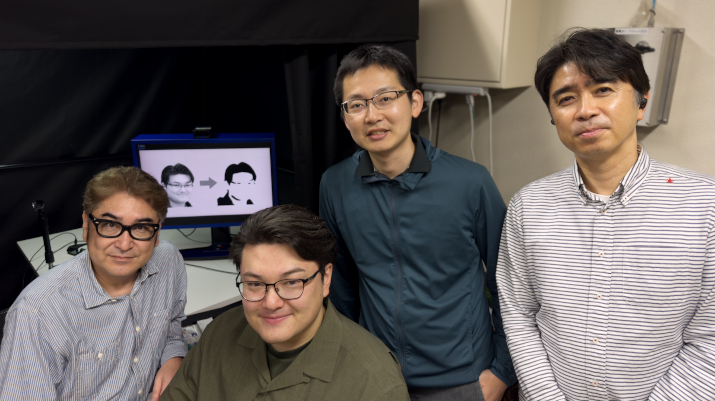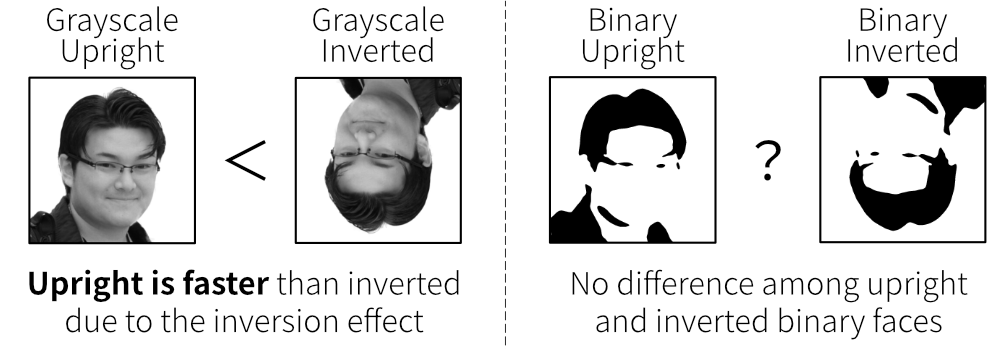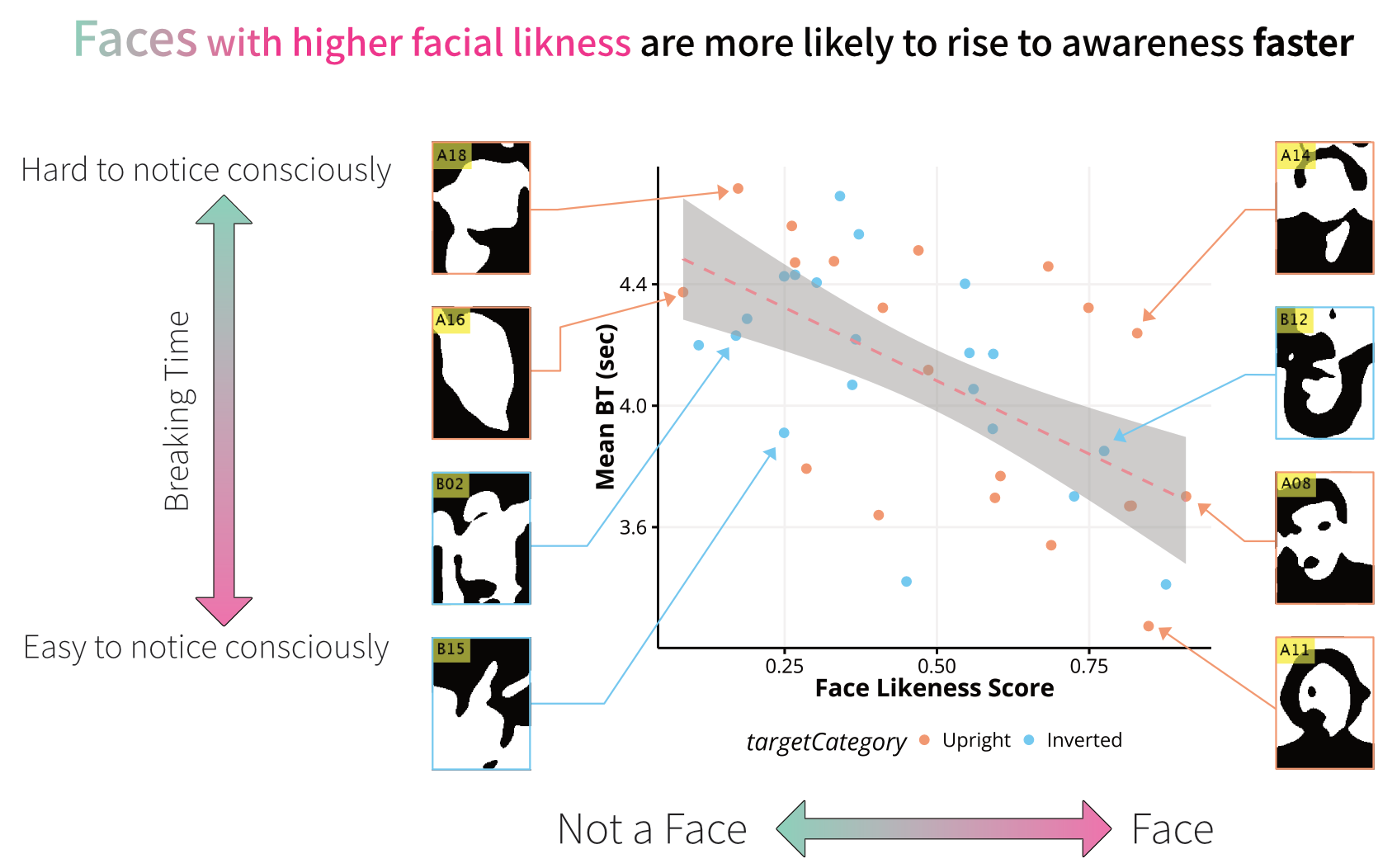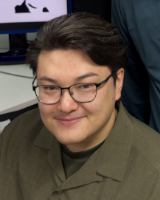

Face-likeness affects Unconscious Processing
Extent of the Facial Ambiguity and Facial Perception Michael Makoto Martinsen
Our brains possess a cognitive mechanism that allows us to quickly recognize faces even with limited visual information. Focusing on this phenomenon, Toyohashi University of Technology investigated how the brain processes ambiguous visual stimuli resembling faces under unconscious conditions. The research team from the Department of Computer Science and Engineering, comprising members from the Visual Perception and Cognition and Cognitive Neuroengineering Laboratories, investigated the processing mechanisms for ambiguous images under unconscious conditions, utilizing a technique called Continuous Flash Suppression (CFS). This method involves rapidly presenting images to one eye to suppress the visual information of the other eye. The research revealed that even ambiguous black-and-white stimuli reach consciousness more quickly when they resemble faces. This suggests that the brain responds rapidly even when facial cues are minimal. These findings were published online in the Journal of Vision on September 27, 2024.
When using CFS, breaking time (BT) is a useful tool to investigate unconscious processing. BT indicates the time it takes for a suppressed stimulus to overcome suppression and become consciously perceived by the participant. Among the four types of stimuli used in the experiment, the study revealed that upright grayscale faces were recognized faster than inverted ones. This is known as the inversion effect and is a well-documented phenomenon in the field of facial recognition. However, the inversion effect was not observed in the case of binary face stimuli—images presented in black and white. This implies that regardless of whether these binary images were upright or inverted, the brain did not exhibit the same recognition bias observed for grayscale faces. Now, does this imply that binarized images do not demonstrate any advantage over grayscale stimuli?

Interestingly, among the binarized images, there were those with a high degree of facial likeness and those without, and an investigation into the relationship between BT and facial likeness revealed a strong correlation. In other words, images with features closer to a face were detected faster than those without. This suggests that even ambiguous stimuli containing facial features like the contours of the eyes and mouth are processed by the brain preferentially over other types of stimuli. The brain exhibits a very high sensitivity to face-like features, emphasizing the uniqueness of facial cues in visual cognition.
Makoto Michael Martinsen, a third-year doctoral student and the first author of this study, commented on the significance: “Our findings underscore the brain's exceptional sensitivity to faces, even under challenging visual conditions. This suggests that facial recognition constitutes a highly specialized system that is pivotal in perceiving and interacting with others.” He further suggests that the results open new avenues for research exploring the influence of emotions, attention, and other factors on facial recognition.

Moving forward, the research team plans to explore how emotional expressions, such as fear or happiness, might affect unconscious processing similarly to face-likeness. Additionally, incorporating techniques like eye-tracking could help identify which facial features participants focus on during unconscious processing, providing further insights into how attention is distributed across different face parts.
This research was supported by JSPS KAKENHI (Grant Numbers JP22K17987 to H.T., JP24H01551 to T.M., JP23KK0183 to T.M., JP20H05956 to S.N.), JSPS Grant-in-Aid for JSPS Fellows (Grant Number JP24KJ1313), and Young Principal Investigator fund JPMJFS2121.
Reference
*Martinsen, M. M., Yoshino, K., Kinzuka, Y., Sato, F., Tamura, H., Minami, T., & Nakauchi, S. (2024). Facial ambiguity and perception: How face-likeness affects breaking time in continuous flash suppression. Journal of Vision, 24(9), 18-18. https://doi.org/10.1167/jov.24.9.18 *Corresponding author.
顔らしさが無意識下処理に影響する
曖昧性と顔の知覚 マーティンセン マイケル誠我々の脳には、限られた視覚情報でも顔を素早く識別できる認知メカニズムがあります。豊橋技術科学大学では、この現象に注目し、無意識下での顔らしい曖昧な視覚刺激に対する脳の処理を調査しました。情報・知能工学系の視覚認知情報学研究室及び認知神経工学研究室の研究チームは、片目に高速で画像を提示して他方の目の視覚情報を抑制する「連続フラッシュ抑制(CFS)」という手法を用いて、無意識下での曖昧な画像に対する処理メカニズムを調べました。研究の結果、曖昧な白黒刺激であっても、顔らしい場合はより早く意識に上ることが判明しました。この結果は、顔に関する手がかりが最小限でも脳が迅速に反応することを示唆しています。なお、この研究成果は2024年9月27日付でJournal of Vision誌にオンライン掲載されました。
CFSとは、一方の目にモザイクのようなランダムな画像が高速で次々と呈示されている間、もう一方の目にターゲット刺激を提示することで、視覚刺激が意識に上ることを抑制する方法です。CFSにおいて抑制突破時間(Breaking time: BT)は無意識下処理を調べる上で重要な指標であり、BTとは、抑制された刺激が抑制を突破し、参加者に意識的に認識されるまでの時間を示す指標を指します。実験で使用された4種類の刺激の中で、正立したグレースケールの顔が逆さの顔よりも速く認識されることが確認されました。これは倒立効果として知られており、顔認識の分野でよく知られた現象です。しかし、白黒で提示された二値化顔刺激の場合、倒立効果は見られませんでした。つまり、これらの二値化画像が正立しているか逆さであるかに関係なく、脳はグレースケールの顔に対して見られるような認識バイアスを示さなかったことを意味しています。では,二値化画像はグレースケールの刺激と比較し,何の優位性も示さないのでしょうか。
興味深いことに、二値化画像の中には顔らしさが高いものとそうでないものが混ざっており、BTと顔らしさとの関係を調査したところ、強い相関が確認できました。つまり、顔に近い特徴を持つ画像は、そうでない画像よりも速く検出されたことを意味します。これは、目や口の輪郭など顔の特徴を含む曖昧な刺激であっても、脳が他の刺激タイプより優先的に処理していることを示唆しています。脳は顔に似た特徴に対して非常に高い感度を示しており、視覚認知における顔の手がかりの独自性を強調する結果となりました。
本研究の第一著者である博士後期課程3年のマーティンセンマイケル誠氏は、本研究の意義について次のように述べています。「困難な視覚条件下においても、脳が顔に対して非常に高い感度を持っていることを強調しています。これは、顔認識が他者を認識し、相互作用する上で極めて重要な特化したシステムであることを示唆しています。」さらに、この結果が、感情や注意などの要因が顔認識に与える影響を探る新たな研究の可能性を開くと提案しています。
今後、研究チームは恐怖や喜びといった感情表現が、顔らしさと同様に無意識下処理にどのような影響を与えるかを探る予定です。加えて、眼球計測などの技術を取り入れることで、無意識下での処理中に参加者がどの顔の特徴に注目しているかを特定し、異なる顔の部位に対する注意についてさらなる洞察を得たいと考えています。
本研究は、JSPS科研費(JP22K17987, JP24H01551, JP23KK0183, JP20H05956)、およびJSPS特別研究員奨励費(JP24KJ1313)、若手PI(JPMJFS2121) の助成を受けたものです。
Researcher Profile

| Name | Michael Makoto Martinsen |
|---|---|
| Affiliation | Department of Computer Science and Engineering |
| Title | Doctor Course Student |
| Fields of Research | Vision Science / Cognitive Science |
| Graduated KOSEN | National Institute of Technology, Gifu College |
